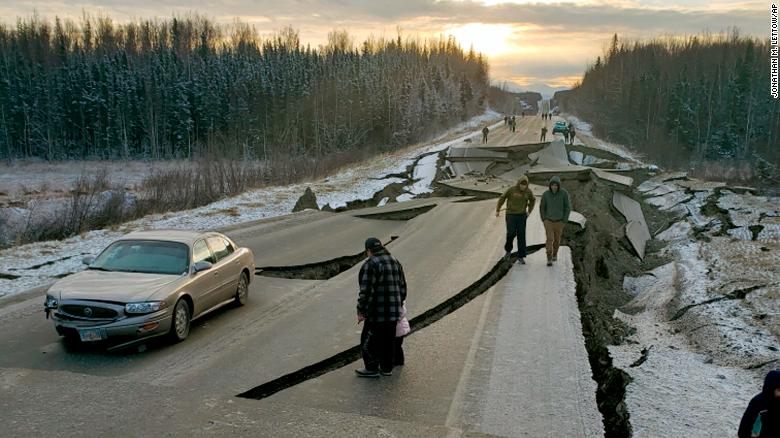More than 1,000 aftershocks rock region after big quake in Alaska

More than 1,000 aftershocks of magnitude 1.5 or greater have shaken Alaska since Friday’s big quake knocked out power, ripped open roads and splintered buildings in Anchorage, US Geological Survey (USGS) geophysicist Randy Baldwin said Sunday.
The majority were of a magnitude of 2.5 or weaker, meaning they weren’t likely felt. But more than 350 of the aftershocks were higher than 2.5, according to USGS data.
Still, local officials said that life was slowly returning to normal after Friday’s magnitude 7 earthquake, even as 4 to 8 inches of snow was expected Sunday.
“It’s interesting how things look different in the light of a new day,” Anchorage Municipal Manager Bill Falsey said, adding that aftershocks have been tapering off.
“Tomorrow is going to be a day closer to a normal sort of day, meaning that we’re going to have a weather event,” said Anchorage Mayor Ethan Berkowitz. “It’s winter in Alaska.”
No fatalities or serious injuries were reported, officials said. In Alaska’s largest city — with a population of about 300,000 — airports, hospitals, emergency services and most businesses were operating.
“The power is up. The heat is on. The communication lines are opening,” Falsey said.
Most of the aftershocks have not rattled Alaskans. But 12 as of Sunday morning more powerful than 4.5 struck near Anchorage and Big Lake, the USGS says.
A 5.2 aftershock about 11 p.m. Friday was the second-biggest since a 5.7 temblor hit minutes after the main quake, said Gavin Hayes, a research geophysicist with the USGS.
“That would have given people a shake and probably a bit of a scare given what they went through yesterday,” he told CNN.
The 7.0 earthquake sent residents scurrying for cover when it hit about 8:30 a.m. Friday. The quake was centered 10 miles northeast of Anchorage.
“The most striking thing about this event was that it was so close to Anchorage,” Hayes said. “That’s why it has caused the damage that we’re seeing.”
The earthquake was not unusual for the region and probably wouldn’t have received much attention had it not struck so close to town, he said.
“This is the second-largest earthquake we’ve had since 1964, which was a very significant earthquake,” Mayor Berkowitz told reporters Saturday, referring to the 9.2 quake that was the most powerful recorded in US history.
“In terms of a disaster, I think it says more about who we are than what we suffered,” Berkowitz said. “I would characterize this as a demonstration that Anchorage is prepared for these kind of emergencies.”
Roads buckled under passing cars and products tumbled from shelves. In court, panicked attorneys scurried under tables as a room rocked from side to side.
“It was very loud when it came,” Berkowitz said Friday. “It was very clear that this was something bigger than what we normally experience. We live in earthquake country … but this was a big one.”
Authorities don’t have firm figures on damage yet, though the Anchorage Police Department reported “major infrastructure damage” around the city. Helicopters and drones were assessing infrastructure across the region. There were no reports of missing people, authorities said.
Alaska Regional Hospital and Providence Alaska Medical Center suffered damage but were able to keep emergency rooms open.
The Anchorage School District canceled classes Monday and Tuesday to assess damage.
Gov. Bill Walker has issued a disaster declaration.
The 7.0 earthquake was felt up to 400 miles away, said state seismologist Michael West. He called it the most significant earthquake in Anchorage since 1964.
Article Source: http://lms.brentphone.kr/board/newspaper_write2.asp?mcl=&opt_gubun=&opt_wrd=&opt_lang=&job=N
Image Source: "https://www.studentnewsdaily.com/wp-content/uploads/2018/12/alaska-road-damage-earthquake2018.jpg" class="img-thumbnail" alt="More than 1,000 aftershocks rock region after big quake in Alaska
VOCABULARY WORDS:
1.Aftershock/ noun : a smaller earthquake following the main shock of a large earthquake.
2.Region /noun : an area or division, especially part of a country or the world having definable characteristics but not always fixed boundaries.
3.Magnitude /noun : the great size or extent of something.
4.Survey /verb : (of a person or their eyes) look carefully and thoroughly at (someone or something), especially so as to appraise them.
5.Anchorage /noun : an area that is suitable for a ship to anchor in.
6.Authority/noun : the power or right to give orders, make decisions, and enforce obedience.
QUESTIONS FOR DISCUSSION:
1. Answer the following about the earthquake that hit Alaska on Friday.
a) How large was the earthquake?
b) What time did it hit?
c) Where was the earthquake centered?
d) Describe the damage it caused.
2. What good news is there to report following such a large earthquake?
3. a) Define temblor, aftershock, geophysicist and seismologist as used in this article.
b) What was the size of the temblor that hit minutes after the main quake?
c) Describe the number and size of the aftershocks.
4. a) Alaska experiences many earthquakes. Why did this quake cause so much damage?
b) What is the significance of Friday’s quake?
5. How does Anchorage Mayor Ethan Berkowitz view the earthquake’s effect on the city?